The Flow Network of Chinese Scientists and Its Driving Mechanisms Based on the Spatial Development Path of CAS and CAE Academicians
Abstract
1. Introduction
2. Literature Review
3. Data and Methods
3.1. Data Sources
3.2. Network Construction
3.3. Measurement Model
3.3.1. Network Attribute Measurement Model
Degree Centrality
Strength Centrality
Betweenness Centrality
3.3.2. Modified Location Quotient Model
4. Spatial Distribution Characteristics of Chinese Scientists’ Development stages
4.1. Birthplaces Mainly Distributed in Eastern Coastal Areas and Yangtze River Basin
4.2. Cities of Undergraduate Graduation Highly Coupled with Domestic Cities with Rich Resources for Higher Education
4.3. Spatial Distribution of Places Where Highest Degree Obtained is More Concentrated
4.4. Workplaces Mainly Distributed in Domestically Developed Cities
5. Characteristics of the Chinese Scientists’ Flow Network
5.1. Network Node Characteristics
5.1.1. Degree Centrality
5.1.2. Strength Centrality
5.1.3. Betweenness Centrality
5.2. Hierarchical Structure
5.3. Node Role Recognition
6. Mechanism Driving the Chinese Scientists’ Flow Network
7. Discussion and Conclusions
Author Contributions
Funding
Acknowledgments
Conflicts of Interest
References
- Dirks, S.; Gurdgiev, C.; Keeling, M. Smarter cities for smarter growth. IBM Glob. Bus. Serv. 2010, 1, 24–31. [Google Scholar]
- Cooke, P. Regional development in the knowledge-based economy: The construction of advantage. J. Technol. Transf. 2005, 31, 5–15. [Google Scholar] [CrossRef]
- Cerna, L. Immigration Policies and the Global Competition for Talent; Palgrave Macmillan: London, UK, 2016. [Google Scholar]
- Cao, C. China’s brain drain at the high end: Why government policies have failed to attract first-rate academics to return. Asian Popul. Stud. 2008, 4, 331–345. [Google Scholar] [CrossRef]
- Porter, M.E. The Competitive Advantage of Nations; Harvard Business School Management Programs Cambridge: Boston, MA, USA, 1993. [Google Scholar]
- Sun, Y.T.; Guo, R.G. Shifting of world’s scientific activity center and transnational migration of scientists. Stud. Sci. Sci. 2018, 36, 1162–1169. [Google Scholar]
- Cole, J.; Cole, S. The Ortega hypothesis: Citation analysis suggests that only a few scientists contribute to scientific progress. Science 1972, 4059, 368–375. [Google Scholar] [CrossRef]
- Saxenian, A. Brain Circulation and Capitalist Dynamics: Chinese Chipmaking and the Silicon Valley-Hsinchu-Shanghai Triangle; Princeton University Press: Princeton, NJ, USA, 2005. [Google Scholar]
- Li, X.M. Roles of scientist and their characteristics. J. Shandong Univ. Sci. Technol. Sci. 2009, 11, 1–12. [Google Scholar]
- Cao, C. China’s Scientific Elite; Routledge: London, UK, 2004. [Google Scholar]
- Yuasa, M. The shifting center of scientific activity in the West. Jpn. Stud. Hist. Sci. 1962, 1, 57–75. [Google Scholar]
- Zhang, B. Research on domestic high—Level talents: Theoretical perspective and latest development. Stud. Sci. Sci. 2018, 36, 1414–1420. [Google Scholar]
- Lacina, J.G. Preparing international students for a successful social experience in higher education. New Dir. High. Educ. 2002, 117, 21–28. [Google Scholar] [CrossRef]
- Abbott, M.; Doucouliagos, C. Competition and efficiency: Overseas students and technical efficiency in Australian and New Zealand universities. Educ. Econ. 2009, 17, 31–57. [Google Scholar] [CrossRef]
- Kaur, B.; Singh, J.M.; Garg, B.R.; Singh, J.; Singh, S. Causes and impact of labour migration: A case study of Punjab agriculture. Agric. Econ. Res. Rev. 2011, 24, 459–466. [Google Scholar]
- Liu, Y. Methods, Technology, and Application of Resource Monitoring of International Scientific Cooperation Based on Data Mining; Science Press: Beijing, China, 2013. [Google Scholar]
- Liu, Y.; Yang, F.J. An analysis of funding characteristics of China’s high—Level S & T talent program. Sci. Res. Manag. 2017, 38, 610–622. [Google Scholar]
- Li, F.; Miao, Y.; Yang, C. How do alumni faculty behave in research collaboration? An analysis of Chang Jiang Scholars in China. Res. Policy 2015, 44, 438–450. [Google Scholar] [CrossRef]
- Zhou, Y.; Guo, Y.; Liu, Y. High-level talent flow and its influence on regional unbalanced development in China. Appl. Geogr. 2018, 91, 89–98. [Google Scholar] [CrossRef]
- Batty, M. The geography of scientific citation. Environ. Plan. A 2003, 35, 761–765. [Google Scholar] [CrossRef]
- Basu, A. Using ISI’s’ Highly Cited Researchers’ to obtain a country level indicator of citation excellence. Scientometrics 2006, 68, 361–375. [Google Scholar] [CrossRef]
- He, S.H. Movement and Formation Mechanism of World Science Center: Based on the Analysis of Nobel Laureates; East China Normal University: Shanghai, China, 2019. [Google Scholar]
- Ren, Q.; Zhu, H.; Li, P. Geographical distribution and regional differentiation of female talents in modern and contemporary China. Acta Geogr. Sin. 2007, 62, 211–220. [Google Scholar]
- Nie, J.; Liu, H. Spatial pattern and the resulting characteristics of talent flows in China. Sci. Geogr. Sin. 2019, 38, 1979–1987. [Google Scholar]
- Zhang, J.; Du, D.; Jiang, H. Regional differences of S & T talents in Jiangsu province. Sci. Geogr. Sin. 2011, 31, 378–384. [Google Scholar]
- Zhang, P.; Zhao, Y.; Ma, Y. Intellectual resources development and regional competitiveness of northeast China. Sci. Geogr. Sin. 2003, 23, 513–518. [Google Scholar]
- Hunter, R.S.; Oswald, A.J.; Charlton, B.G. The elite brain drain. Econ. J. 2009, 119, F231–F251. [Google Scholar] [CrossRef]
- Zarifa, D.; Walters, D. Revisiting Canada’s brain drain: Evidence from the 2000 cohort of Canadian university graduates. Can. Public Policy 2008, 34, 305–319. [Google Scholar] [CrossRef]
- Wang, X.; Mao, W.; Wang, C.; Peng, L.; Hou, H. Chinese elite brain drain to USA: An investigation of 100 United States national universities. Scientometrics 2013, 97, 37–46. [Google Scholar] [CrossRef]
- Saxenian, A. BRAIN CIRCULATION. How high-skill immigration makes everyone better off. Brook. Rev. 2002, 20, 28–31. [Google Scholar] [CrossRef]
- Mulec, B. Brain Talent Circulation: A New Aim for Countries Connecting with Diasporas. DVE Domov. Homel. 2011, 33, 109–122. [Google Scholar]
- OCDE, O. International Migration Outlook 2016; OECD Publishing: Paris, France, 2016. [Google Scholar]
- Huang, K.G.; Ertug, G. Mobility, retention and productivity of genomics scientists in the United States. Nat. Biotechnol. 2014, 32, 953. [Google Scholar] [CrossRef]
- Li, R.; Wu, D.; Bao, J. Evolution of temporal and spatial pattern and driving mechanisms of agglomerative growth of senior science talents: A case study of academicians of CAS. Prog. Geogr. 2013, 32, 1123–1138. [Google Scholar]
- Luo, S.; Wang, A.; Gao, R. Analyses of factors of high-level falents’ migration and significance of establishing anti-selection mechanisms among regions. Sci. Geogr. Sin. 2009, 29, 779–786. [Google Scholar]
- Cowling, M.; Lee, N. How entrepreneurship, culture and universities influence the geographical distribution of UK talent and city growth. J. Manag. Dev. 2017, 36, 178–195. [Google Scholar] [CrossRef]
- Gao, X.; Fan, W.; Leng, S. Young scientist fund of the National natural science foundation of China in geography. Prog. Geogr. 2018, 37, 174–182. [Google Scholar]
- Appelt, S.; Van Beuzekom, B.; Galindo-Rueda, F.; De Pinho, R. Which Factors Influence the International Mobility of Research Scientists? Elsevier: Amsterdam, The Netherlands, 2015; pp. 177–213. [Google Scholar]
- Van Bouwel, L.; Lykogianni, E.; Veugelers, R. Mobility of European Researchers to the Us: Student Mobility vs. Researcher Mobility; Katholieke Univer-siteit Leuven: Leuven, Belgium, 2011. [Google Scholar]
- Keller, W. Geographic localization of international technology diffusion. Am. Econ. Rev. 2002, 92, 120–142. [Google Scholar] [CrossRef]
- Gaulé, P. Who comes back and when? Return migration decisions of academic scientists. Econ. Lett. 2014, 124, 461–464. [Google Scholar] [CrossRef]
- Conchi, S.; Michels, C. An analysis of Germany, Austria, France and Great Britain; Fraunhofer ISI: Karlsruhe, Germany, 2014. [Google Scholar]
- Fallick, B.; Fleischman, C.A.; Rebitzer, J.B. Job-hopping in Silicon Valley: Some evidence concerning the microfoundations of a high-technology cluster. Rev. Econ. Stat. 2006, 88, 472–481. [Google Scholar] [CrossRef]
- Saxenian, A. Silicon Valley’s new immigrant high-growth entrepreneurs. Econ. Dev. Q. 2002, 16, 20–31. [Google Scholar] [CrossRef]
- Walz, U. Innovation, foreign direct investment and growth. Economica 1997, 64, 63–79. [Google Scholar] [CrossRef]
- Duan, D.; Du, D.; Gui, Q. The geography of Chinese entrepreneurial development. Hum. Geogr. 2018, 33, 102–112. [Google Scholar]
- Sandström, U. Combining curriculum vitae and bibliometric analysis: Mobility, gender and research performance. Res. Eval. 2009, 18, 135–142. [Google Scholar] [CrossRef]
- Duan, D.; Liu, C.; Du, D. Spatial dependency of bus-line distribution based on bipartite network: A case study of Beijing city. Acta Geogr. Sin. 2016, 71, 2185–2198. [Google Scholar]
- Sen, P.; Dasgupta, S.; Chatterjee, A.; Sreeram, P.A.; Mukherjee, G.; Manna, S.S. Small-world properties of the Indian railway network. Phys. Rev. E 2003, 67, 36106. [Google Scholar] [CrossRef]
- Bastian, M.; Heymann, S.; Jacomy, M. Gephi: An open source software for exploring and manipulating networks. In Proceedings of the Third International AAAI Conference on Weblogs and Social Media, San Jose, CA, USA, 17–20 May 2009. [Google Scholar]
- Batagelj, V.; Mrvar, A. Pajek-program for large network analysis. Connections 1998, 21, 47–57. [Google Scholar]
- Van Eck, N.J.; Waltman, L. Text mining and visualization using VOSviewer. arXiv 2011, arXiv:1109.2058. [Google Scholar]
- Isserman, A.M. The location quotient approach to estimating regional economic impacts. J. Am. Inst. Plan. 1977, 43, 33–41. [Google Scholar] [CrossRef]
- Wu, D.; Liu, C.; Gu, S. Comparative analysis of senior scientific talents and senior technological talents-based on the case study of CAS and CAE members. Chin. Soft Sci. 2005, 8, 70–75. [Google Scholar]
- Lee, E.S. A theory of migration. Demography 1966, 3, 47–57. [Google Scholar] [CrossRef]
- Schultz, T.W. Investment in human capital. Am. Econ. Rev. 1961, 51, 1–17. [Google Scholar]
- Doeringer, P.B.; Piore, M.J. Internal Labor Markets and Manpower Analysis; ME Sharpe: New York, NY, USA, 1985. [Google Scholar]
- Rogers, A. Model migration schedules: An application using data for the Soviet Union. Can. Stud. Popul. 1978, 5, 85–96. [Google Scholar] [CrossRef]
- Trajtenberg, M.; Henderson, R.; Jaffe, A. University versus corporate patents: A window on the basicness of invention. Econ. Innov. New Technol. 1997, 5, 19–50. [Google Scholar] [CrossRef]
- Favell, A.; Feldblum, M.; Smith, M.P. The human face of global mobility: A research agenda. Society 2007, 44, 15–25. [Google Scholar] [CrossRef]
- Liu, Y.; Shen, J. Spatial patterns and determinants of skilled internal migration in China, 2000–2005. Pap. Reg. Sci. 2014, 93, 749–771. [Google Scholar] [CrossRef]
- Zhang, B.; Ding, J. Spatial distribution and change trend of high-level talent in China. J. Arid Land Resour. Environ. 2019, 33, 32–36. [Google Scholar]
- Dai, Y.; Kong, D.; Liu, S. Returnee talent and corporate investment: Evidence from China. Eur. Account. Rev. 2018, 27, 313–337. [Google Scholar] [CrossRef]
- Bersin, J.; Chamorro-Premuzic, T. New ways to gauge talent and potential. Mit Sloan Manag. Rev. 2019, 60, 7–10. [Google Scholar]
- Shi, Q.J.; Liu, T. Glimpsing China’s future urbanization from the geography of a floating population. Environ. Plan. A Econ. Space 2019, 51, 817–819. [Google Scholar] [CrossRef]
- Ding, J.; Liu, Z.; Cheng, D. Areal differentiation of inter-provincial migration in China and characteristics of the flow field. Acta Geogr. Sin. 2005, 1, 106–114. [Google Scholar]
- Wang, R.Y.; Huang, X.; Xue, D.S. Spatio-temporal Change of Facaulty Members of Higher Education Institute and Its Influential Factors in China in 2005–2015. Sci. Geogr. Sin. 2019, 39, 1199–1207. [Google Scholar]
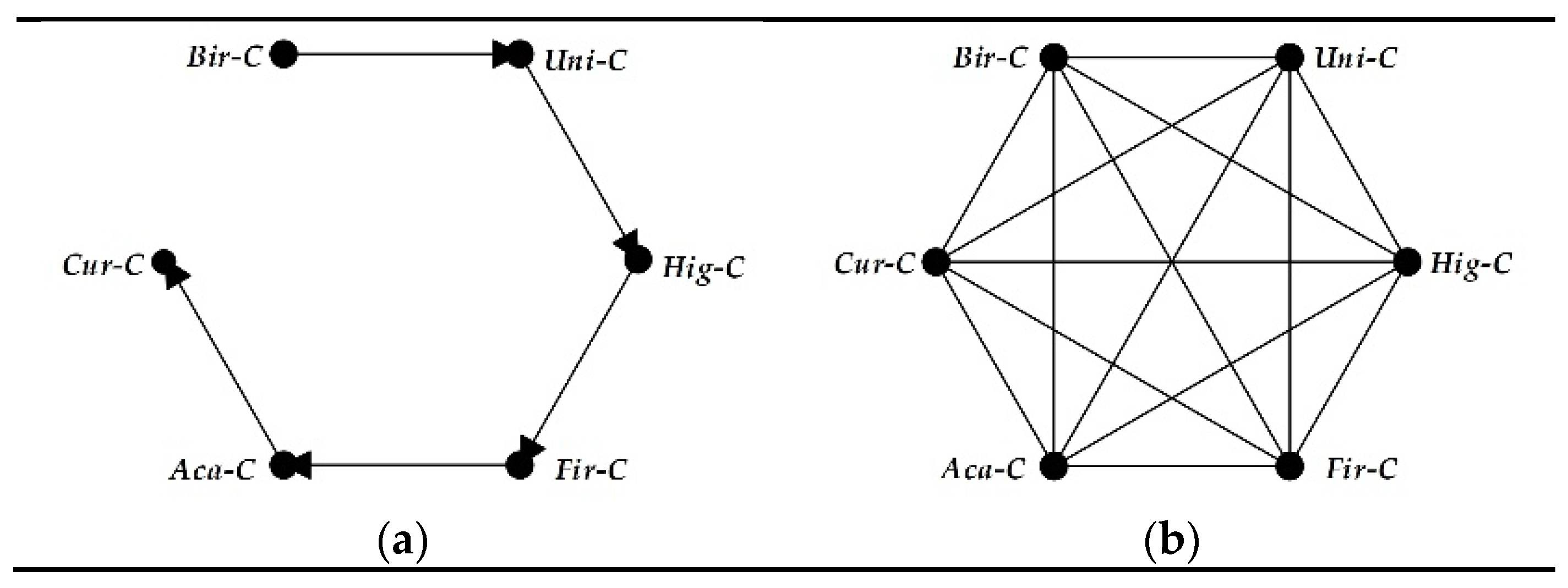
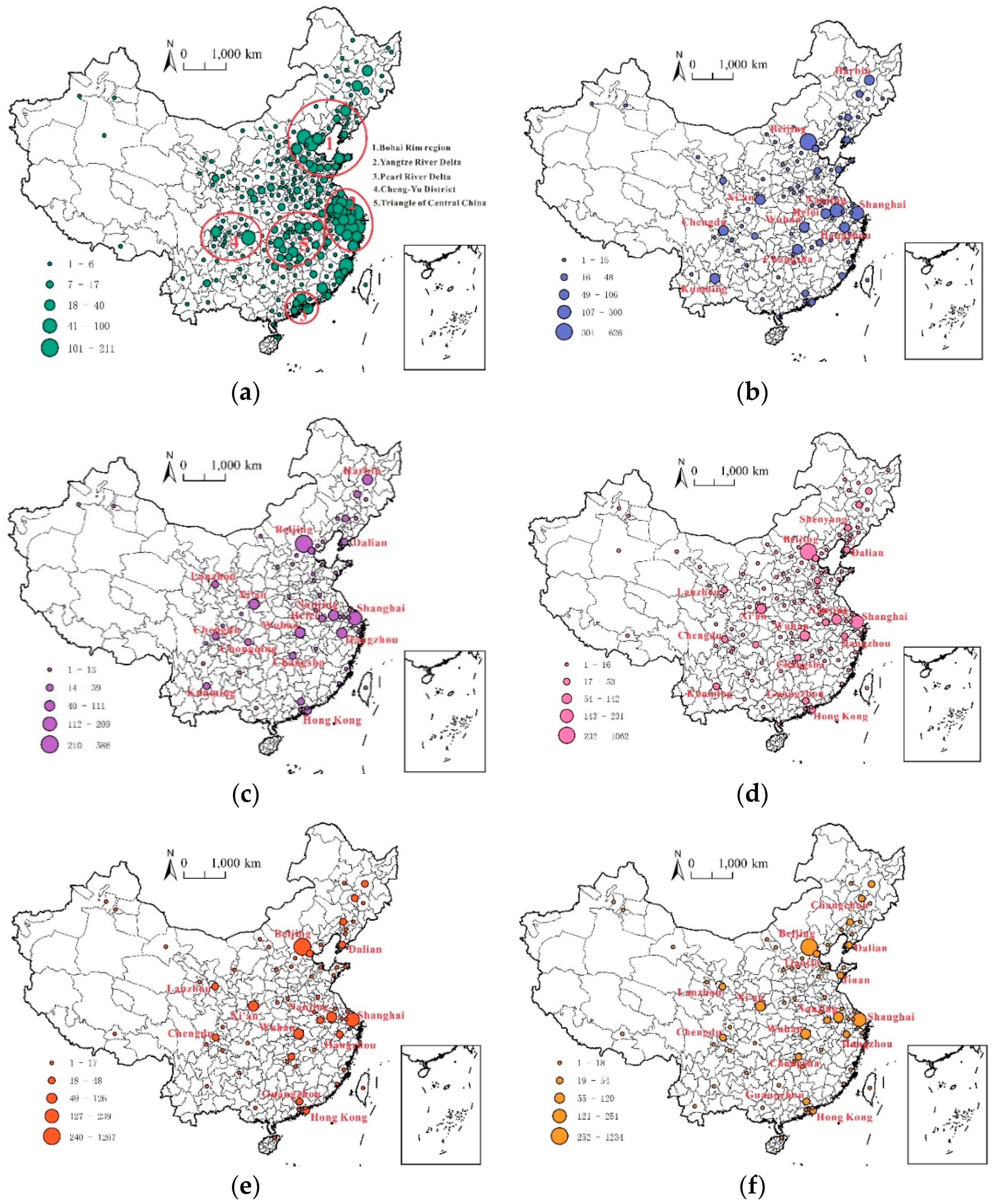
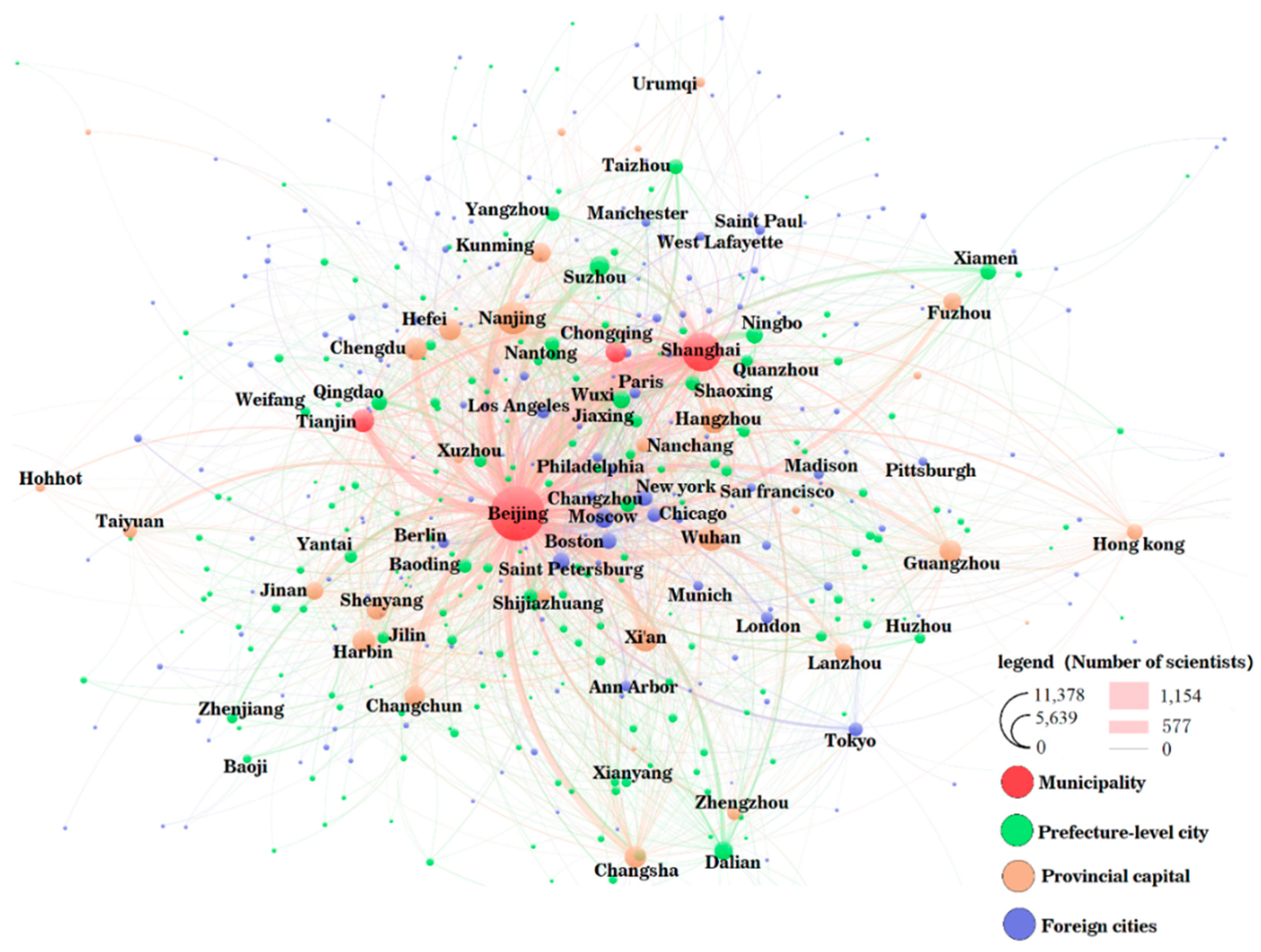
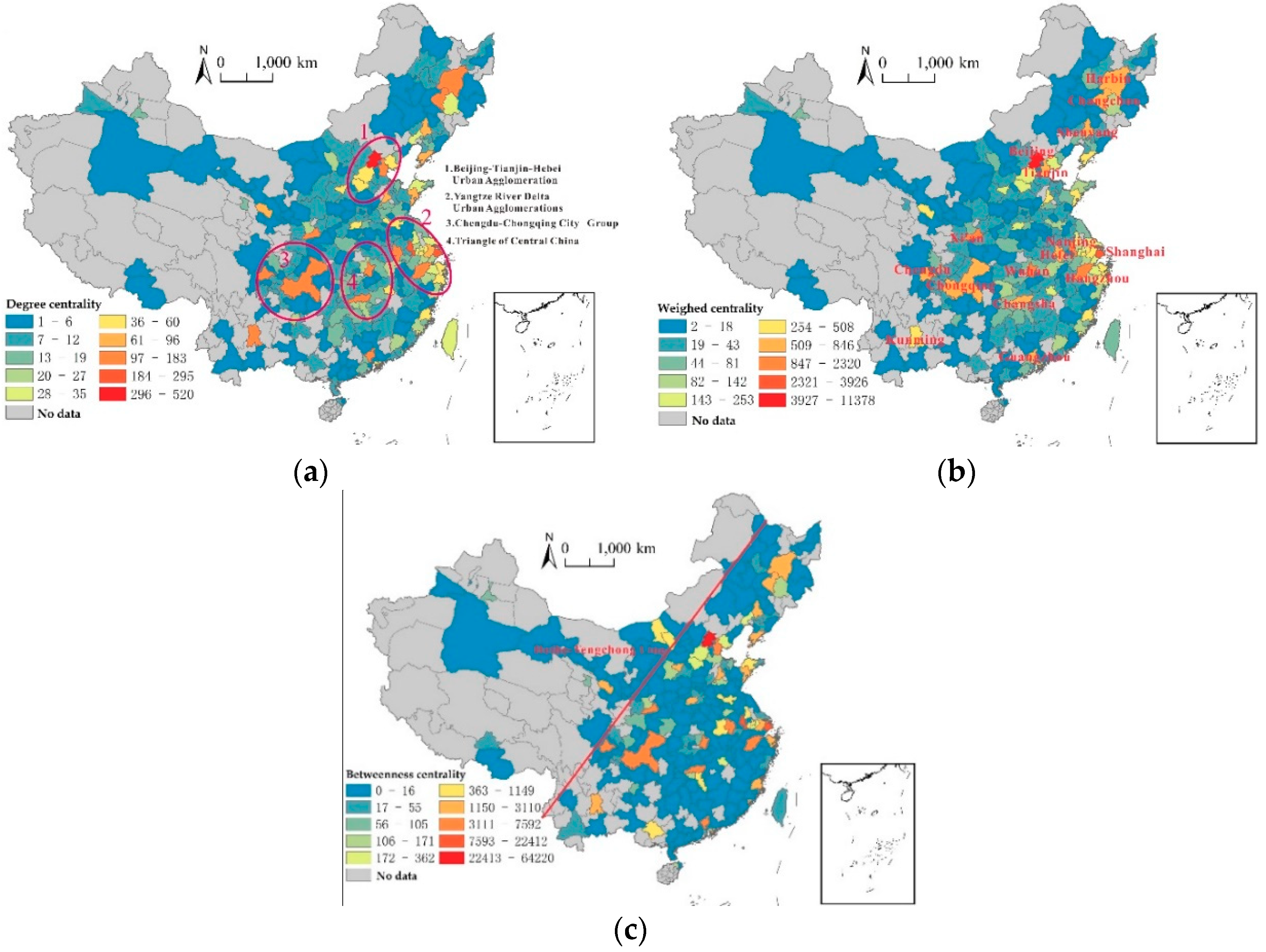
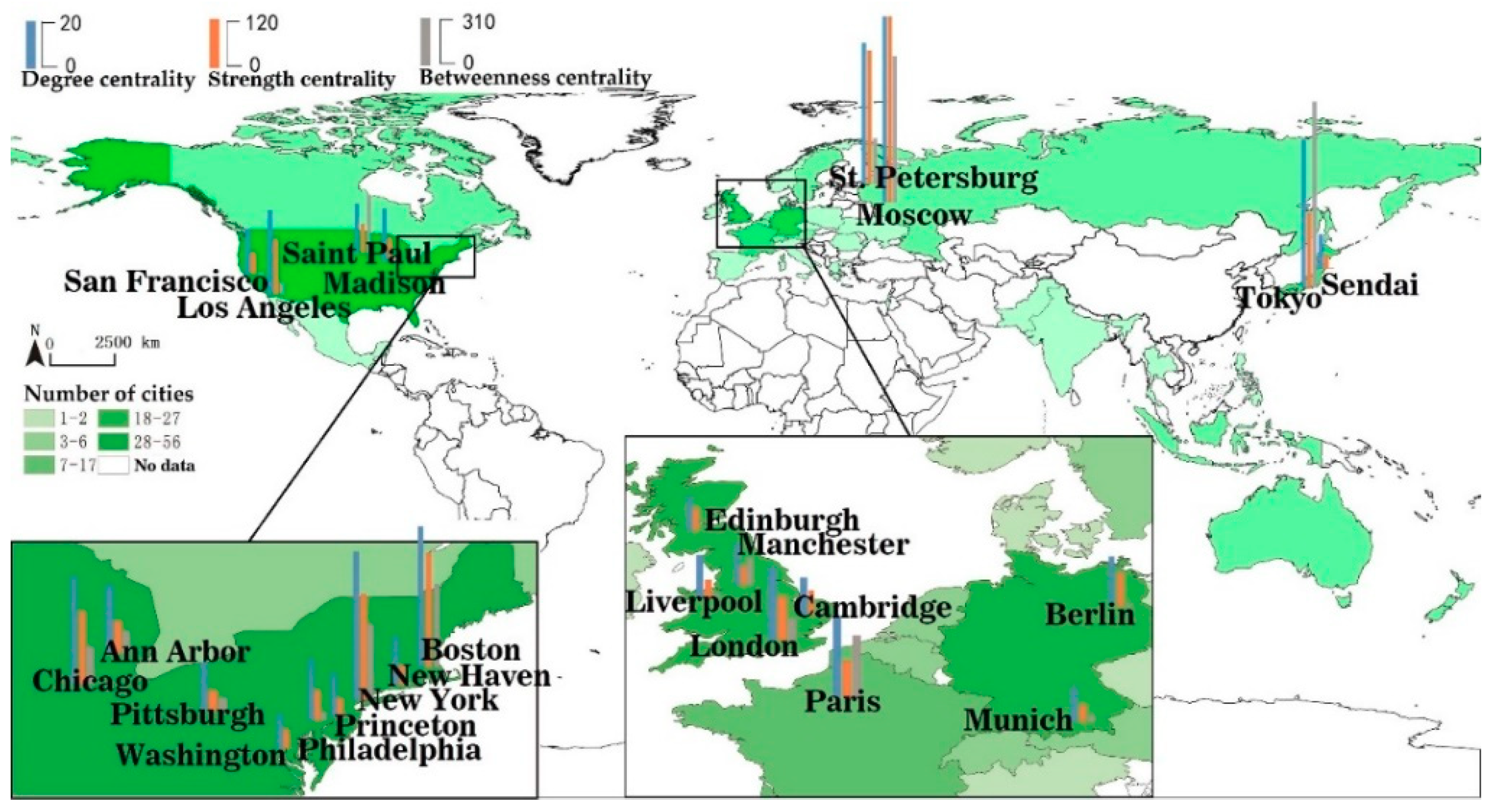
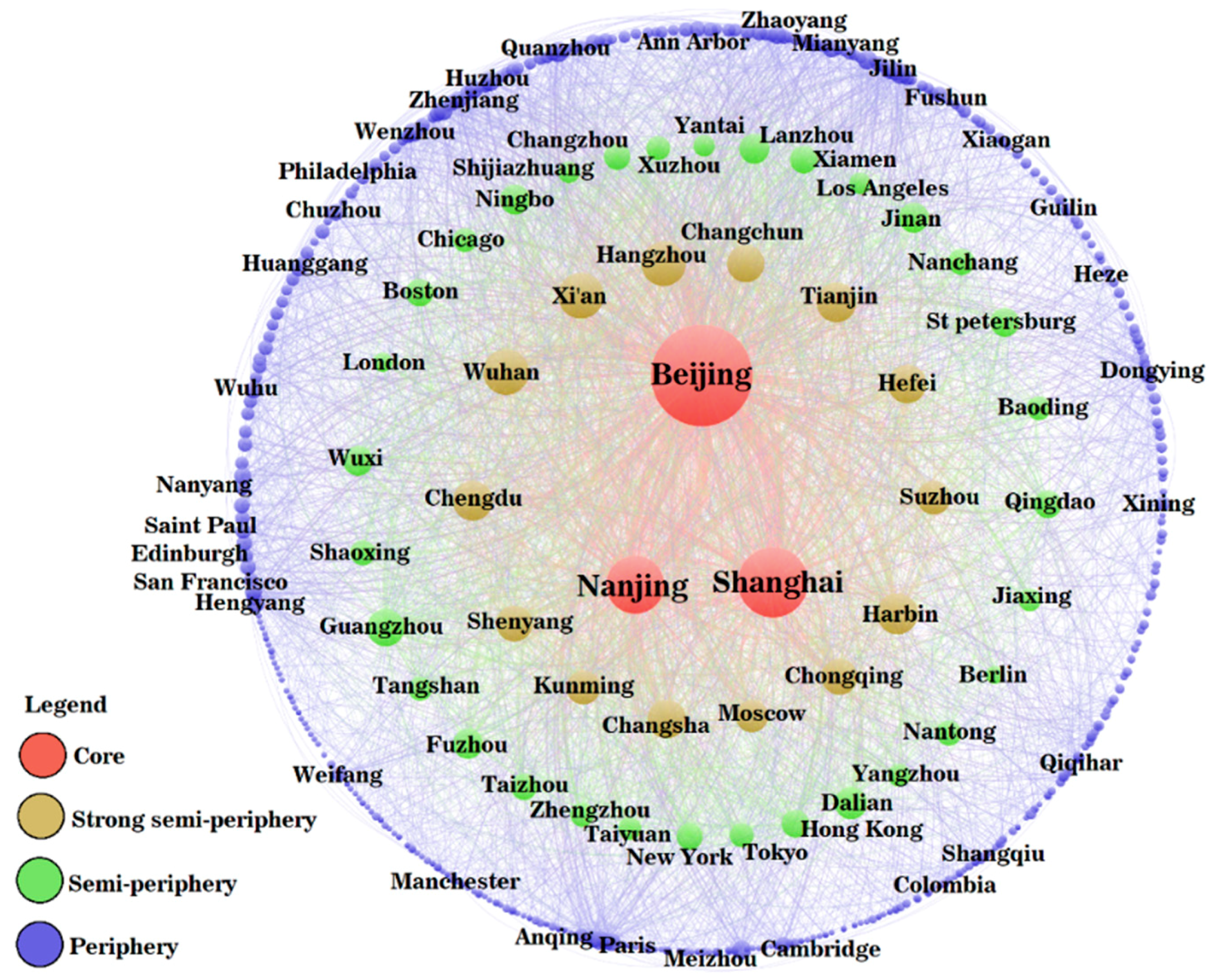
| Level | No. Nodes | Average Degree Centrality | Average Intensity Centrality | Average Eccentricity | Average Intimacy Centrality | Average Betweenness Centrality | Density |
|---|---|---|---|---|---|---|---|
| 1 | 3 | 355.00 | 5874.67 | 3.00 | 0.63 | 34,147.95 | 0.79 |
| 2 | 14 | 122.29 | 784.07 | 4.00 | 0.52 | 3907.64 | 0.45 |
| 3 | 32 | 51.72 | 253.84 | 3.88 | 0.49 | 862.37 | 0.19 |
| 4 | 420 | 7.35 | 20.30 | 4.05 | 0.40 | 19.81 | 0.03 |
| Whole network | 469 | 16.03 | 96.49 | 4.03 | 0.41 | 411.66 | 0.06 |
| Type and Quantity | City |
|---|---|
| Accomplished and stable type (1) | Beijing |
| Stable type (2) | Guangzhou, Qingdao |
| Accomplished type (1) | Hong Kong |
| Initial type (5) | Zhengzhou, Dalian, Changchun, Lanzhou, Shenyang |
| Further-study type (9) | Harbin, Moscow, Los Angles, Boston, St. Petersburg, London, Tokyo, New York, Chicago |
| Educational type (14) | Taiyuan, Xi’an, Nanchang, Changsha, Wuhan, Shanghai, Tianjin, Chengdu, Jinan, Nanjing, Xiamen, Hefei, Hangzhou, Kunming |
| Foundational type (18) | Xuzhou, Chongqing, Fuzhou, Yangzhou, Jilin, Yantai, Wuxi, Baoding, Suzhou, Ningbo, Nantong, Shijiazhuang, Tangshan, Taizhou, Shaoxing, Jiaxing, Quanzhou, Changzhou |
© 2019 by the authors. Licensee MDPI, Basel, Switzerland. This article is an open access article distributed under the terms and conditions of the Creative Commons Attribution (CC BY) license (http://creativecommons.org/licenses/by/4.0/).
Share and Cite
Shi, W.; Du, D.; Yang, W. The Flow Network of Chinese Scientists and Its Driving Mechanisms Based on the Spatial Development Path of CAS and CAE Academicians. Sustainability 2019, 11, 5938. https://doi.org/10.3390/su11215938
Shi W, Du D, Yang W. The Flow Network of Chinese Scientists and Its Driving Mechanisms Based on the Spatial Development Path of CAS and CAE Academicians. Sustainability. 2019; 11(21):5938. https://doi.org/10.3390/su11215938
Chicago/Turabian StyleShi, Wentian, Debin Du, and Wenlong Yang. 2019. "The Flow Network of Chinese Scientists and Its Driving Mechanisms Based on the Spatial Development Path of CAS and CAE Academicians" Sustainability 11, no. 21: 5938. https://doi.org/10.3390/su11215938
APA StyleShi, W., Du, D., & Yang, W. (2019). The Flow Network of Chinese Scientists and Its Driving Mechanisms Based on the Spatial Development Path of CAS and CAE Academicians. Sustainability, 11(21), 5938. https://doi.org/10.3390/su11215938





